《分析化学》课程教学资源(课件讲稿,英文)Chapter 2 Errors and data treatment in quantitative analysis

G山东理子大军 Analytical Chemistry Chapter 2 Errors and data treatment in quantitative analysis
Analytical Chemistry Chapter 2 Errors and data treatment in quantitative analysis 2023/7/28 1
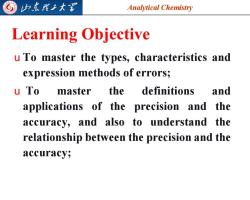
G 归东理工大军 Analytical Chemistry Learning Objective u To master the types,characteristics and expression methods of errors; u To master the definitions and applications of the precision and the accuracy,and also to understand the relationship between the precision and the accuracy;
Analytical Chemistry Learning Objective u To master the types, characteristics and expression methods of errors; u To master the definitions and applications of the precision and the accuracy, and also to understand the relationship between the precision and the accuracy; 2023/7/28 2

归东理2大军 Analytical Chemistry u To know about the distribution rules of random error,and master the definitions, functions and calculating methods of confidence levels and confidence intervals; u To know about the evaluation methods of the quantitative data,realize the importance of improving the accuracy of analytical results;
Analytical Chemistry u To know about the distribution rules of random error, and master the definitions, functions and calculating methods of confidence levels and confidence intervals; u To know about the evaluation methods of the quantitative data, realize the importance of improving the accuracy of analytical results; 2023/7/28 3
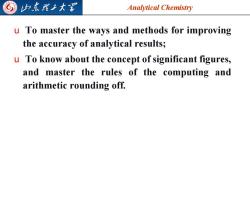
G 归东龙子大写 Analytical Chemistry u To master the ways and methods for improving the accuracy of analytical results; u To know about the concept of significant figures, and master the rules of the computing and arithmetic rounding off
Analytical Chemistry u To master the ways and methods for improving the accuracy of analytical results; u To know about the concept of significant figures, and master the rules of the computing and arithmetic rounding off. 2023/7/28 4
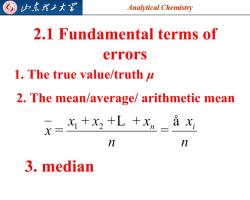
归东理工大军 Analytical Chemistry 2.1 Fundamental terms of errors 1.The true value/truth 2.The mean/average/arithmetic mean x=++L+2=且龙 n n 3,median
Analytical Chemistry 2.1 Fundamental terms of errors 1. The true value/truth μ 2. The mean/average/ arithmetic mean 3. median 2023/7/28 5

G 归东龙子大写 Analytical Chemistry The middle numerical value in a set of values. 4.Accuracy Accuracy describes the nearness of an experimental value to the true value. Accuracy is expressed as error E=x-m relative error (RE)is calculated by the following formula:
Analytical Chemistry 4. Accuracy Accuracy is expressed as error relative error (RE) is calculated by the following formula: The middle numerical value in a set of values. Accuracy describes the nearness of an experimental value to the true value. 2023/7/28 6
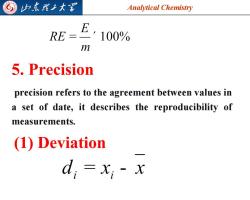
归东理工大军 Analytical Chemistry E RE= '100% m 5.Precision precision refers to the agreement between values in a set of date,it describes the reproducibility of measurements. (1)Deviation d;=xi-x
Analytical Chemistry 5. Precision precision refers to the agreement between values in a set of date, it describes the reproducibility of measurements. (1) Deviation 2023/7/28 7

G 归东我王大 Analytical Chemistry (2) Relative deviation RD=4100% X (3)average deviation ax;-x d i=l n
Analytical Chemistry (2) Relative deviation (3) average deviation 2023/7/28 8
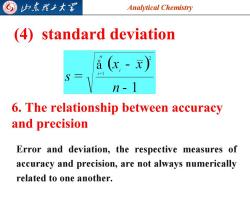
归东我工大军 Analytical Chemistry (4) standard deviation a (x-x)》 i=1 n-1 6.The relationship between accuracy and precision Error and deviation,the respective measures of accuracy and precision,are not always numerically related to one another
Analytical Chemistry (4) standard deviation 6. The relationship between accuracy and precision Error and deviation, the respective measures of accuracy and precision, are not always numerically related to one another. 2023/7/28 9
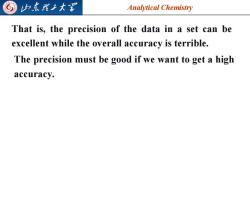
归东理工大图 Analytical Chemistry That is,the precision of the data in a set can be excellent while the overall accuracy is terrible. The precision must be good if we want to get a high accuracy
Analytical Chemistry That is, the precision of the data in a set can be excellent while the overall accuracy is terrible. The precision must be good if we want to get a high accuracy. 2023/7/28 10
按次数下载不扣除下载券;
注册用户24小时内重复下载只扣除一次;
顺序:VIP每日次数-->可用次数-->下载券;
- 《分析化学》课程教学课件(PPT讲稿)重量分析2/2.ppt
- 《分析化学》课程教学课件(PPT讲稿)重量分析1/2.ppt
- 《分析化学》课程教学课件(PPT讲稿)酸碱滴定法(acid-base titration).ppt
- 《分析化学》课程教学课件(PPT讲稿)络合滴定2/2.ppt
- 《分析化学》课程教学课件(PPT讲稿)络合滴定1/2.ppt
- 《分析化学》课程教学课件(PPT讲稿)滴定分析法概述.ppt
- 《分析化学》课程教学课件(PPT讲稿)沉淀滴定法.ppt
- 《分析化学》课程教学课件(PPT讲稿)氧化还原滴定法 Oxidation-Reduction Titration.ppt
- 《分析化学》课程教学课件(PPT讲稿)分析化学中的误差.ppt
- 《物理化学》课程教学课件(PPT讲稿)第一章 热力学第一定律.ppt
- 《分析化学》课程教学课件(PPT讲稿)酸碱滴定法(acid-base titration).ppt
- 《物理化学》课程教学课件(PPT讲稿)电化学_电解质溶液.ppt
- 《物理化学》课程教学课件(PPT讲稿)热力学第一定律及其应用.ppt
- 《物理化学》课程教学课件(PPT讲稿)总结.ppt
- 《物理化学》课程教学课件(PPT讲稿)第八章 表面现象分散系统.ppt
- 《物理化学》课程教学课件(PPT讲稿)第五章 多相平衡 Phase Equilibrium.ppt
- 《物理化学》课程教学课件(PPT讲稿)第三章 化学势.ppt
- 《物理化学》课程教学课件(PPT讲稿)第七章 电化学.ppt
- 《物理化学》课程教学课件(PPT讲稿)第九章 化学动力学基本原理.ppt
- 《物理化学》课程教学课件(PPT讲稿)总结.ppt
- 《分析化学》课程教学课件(PPT讲稿,英文)Chapter 4 Acid-base equilibria.ppt
- 《分析化学》课程教学课件(PPT讲稿,英文)Chapter 6 Oxidation-reduction titration.ppt
- 《分析化学》课程教学课件(PPT讲稿)绪论 Analytical chemistry(化学分析部分).ppt
- 《分析化学》课程各章 思考题(含答案)第七章.doc
- 《分析化学》课程各章 思考题(含答案)第九章.doc
- 《分析化学》课程各章 思考题(含答案)第八章.doc
- 《分析化学》课程各章 思考题(含答案)第十章.doc
- 《分析化学》课程教学资源(各章知识点)第六章 配位滴定法、第七章 氧化还原滴定法、第八章 沉淀滴定法.doc
- 《分析化学》课程教学资源(各章知识点)第一章 概论、第三章 误差及数据处理、第五章 酸碱滴定法.doc
- 《高分子化学实验》课程实验指导(讲义)实验五 聚丙烯腈的部分水解反应.doc
- 《高分子化学实验》课程实验指导(讲义)实验四 三聚氰胺甲醛树脂的合成及层压板的制备.doc
- 《高分子化学实验》课程实验指导(讲义)实验五 本体聚合MMA及其透光率测定.doc
- 《高分子化学实验》课程实验指导(讲义)实验二 丙烯酰胺溶液聚合及其干燥加工.doc
- 《高分子化学实验》课程实验指导(讲义)实验四 醋酸乙烯酯的乳液聚合及固含量测定.doc
- 《生物仪器分析》课程教学课件(讲稿)气相色谱液相色谱导论(气相色谱法、高效液相色谱法).ppt
- 高等教育出版社:《现代仪器分析》教材书籍PDF电子版(扫描版,第三版,主编:刘约权).pdf
- 《生物仪器分析》课程教学课件(讲稿)第一章 绪论(山东理工大学:徐征豹).pdf
- 《生物仪器分析》课程教学课件(讲稿)第七章 分子发光分析法.pdf
- 《生物仪器分析》课程教学课件(讲稿)第三章 原子发射光谱法.pdf
- 《生物仪器分析》课程教学课件(讲稿)第二章 光分析法导论——以物质的光学性质为基础而建立的分析方法.pdf
